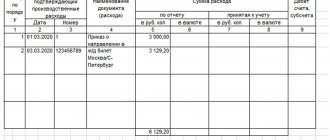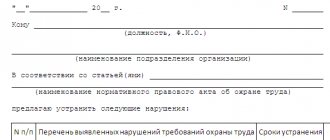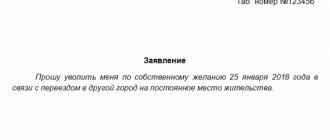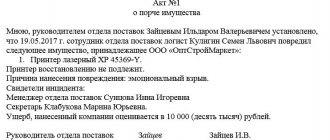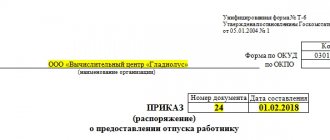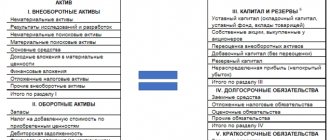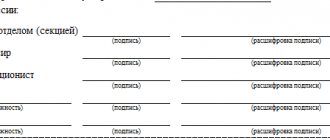When is the act drawn up in form N-1 and what information does it contain?
Form N-1 report is a mandatory element of the package of documents drawn up during the accident investigation process.
For more information about what documents are included in this package, see this material .
You will find a step-by-step algorithm for conducting an investigation of the National Assembly in the Guide from ConsultantPlus. A free trial of full access to the legal system is available.
The form of the report on an industrial accident was approved by Decree of the Ministry of Labor of Russia dated October 24, 2002 No. 73.
The information specified in the act can be divided into 3 blocks:
- initial data and information (about the victim, employer, composition of the NS investigation commission, etc.);
- description of the circumstances of the accident (including the type of incident, causes of the accident, witnesses, etc.);
- organizational and final block of information.
For details on filling out the two above blocks, see the material “Act on an accident at work (nuances)” .
In the following sections we will dwell in more detail on the nuances of the design of the organizational and final block of information.
Sending acts to interested persons and organizations
Copies of accident reports along with investigation materials are sent by the chairman of the commission,
in all cases:
- The employer who sent the victim to work.
in all cases except mild NS with one victim:
- to the relevant state labor inspectorate;
- the prosecutor's office was notified of the accident;
- To the territorial association of the trade union;
- To Rostrud - if at least one person was seriously injured or died;
- To Rostechnadzor (if the accident occurred at a facility under its supervision).
If during the investigation of an accident that occurred with a person who performed work on the basis of a civil law contract (clause 16 of the Resolution of the Ministry of Labor No. 73), information was established that gave sufficient grounds to believe that the specified contract actually regulated the labor relations of the victim with the employer, then the accident investigation report, together with other investigation materials, is sent by the state labor inspector to the court in order to establish the nature of the legal relations between the parties to the said agreement. The decision on the final registration of this accident is made by the state labor inspector, depending on the merits of the said court decision.
Scheme 3 – Who to send Act N-1 to
In addition, information about accidents that occurred and the causes that led to the tragedy are transferred to the relevant authorities, in accordance with Order No. 21, issued by the Federal Service for Labor and Employment on February 21, 2005, to conduct an analytical analysis of the causes of industrial injuries and, if possible, take measures for it prevention.
“Percentage” qualification of the degree of guilt of the victim
An important aspect when filling out the act f. N-1 - determining the degree of guilt of the victim if the insurance company is insured.
In Art. 229.2 of the Labor Code of the Russian Federation says the following about this. The degree of guilt of the insured (in%) is established by the investigation commission:
- when it is revealed that harm to the victim’s health has occurred or increased as a result of his gross negligence;
- taking into account the conclusion of the trade union (in certain cases, the state labor inspector who independently investigates the NS) or another body authorized by the employees.
The purpose of such a “percentage qualification” of the victim’s fault is the need to recalculate insurance payments intended to restore health if there was gross negligence on the part of the victim.
IMPORTANT! The amount of monthly insurance payments may be reduced (but not more than by 25%) depending on the degree of guilt of the insured (Article 14 of the Law “On Compulsory Social Insurance against Social Security at Work” dated July 24, 1998 No. 125-FZ).
The following must be taken into account:
- for those guilty of accidents, but not victims, the percentage is not established and insurance payments are not paid;
- in the event of the death of the victim, payments cannot be reduced;
- If the injury to health occurred due to the intent of the insured, which is confirmed by the conclusion of law enforcement agencies, compensation is not paid.
Thus, the amount of material compensation is directly dependent on the decision of the investigation commission on the degree of guilt of the victim. In this regard, the members of the commission have a responsible mission to correctly qualify the actions of the victim.
In particular, they must find out whether the victim’s actions were:
- haste;
- personal negligence;
- imprudence;
- disregard for personal safety;
- the result of fatigue (fatigue);
- uncoordinated actions;
- incorrect assessment of the situation, etc.
The above actions of the victim are considered in conjunction with the actions of the employer. The commission is obliged to establish whether the employer has done everything in his power to prevent NS, including:
- whether timely and high-quality training of the victim in safe work practices was carried out;
- whether he was provided with personal protective equipment;
- whether safe working conditions have been created;
- whether supervisory functions on labor safety issues have been performed by the company's responsible persons;
- what is the condition of the safety equipment (locking, fencing, etc.);
- do the provisions of the internal instructions on labor protection comply with the requirements of regulatory documents (GOSTs, federal and industry standards, etc.), etc.
Only after a high-quality and comprehensive investigation in the act f. N-1 the corresponding “percentage” entry is made.
After the victim recovers
After the victim has recovered from a fracture or other injury and returned to work, the responsible person draws up a message about the consequences (on Form 8), which he sends:
- to the territorial body of Rostrud;
- to the industry control body (if any);
- in ter. FSS body, if it will pay compensation.
If the victim became disabled or died, the notification is sent one month after the investigation is completed.
Thus, for registering an accident at work, there are regulations established by law. The form depends on the specific features of a particular case.
Actions based on the results of the investigation
An employer that respects itself and its workforce carries out a regular set of measures aimed at preventing accidents. If labor safety issues in a company are resolved comprehensively and the employer does not skimp on the labor safety of its employees, accident situations become unlikely.
What points to pay attention to when organizing a labor protection system, read the article “Where to start labor protection at an enterprise (nuances)?”
If the accident did occur, when drawing up the act f. N-1 will have to fill out clause 11 “Measures to eliminate the causes of the accident, deadlines.”
This step in the overall scheme of investigating NS and filling out documentation has important preventive value. It allows:
- analyze the causes of the onset of NS;
- study in detail the effectiveness of the company’s occupational health and safety system;
- assess the competence of specialists responsible for occupational safety;
- determine measures to prevent accidents in the future.
The last of these points should be reflected in the act f. N-1. At the same time, the circumstances of the NS and the measures developed based on the results of the investigation must be interconnected. This will make it possible to build an effective mechanism for preventing (preventing) NS.
Requirements for the developed activities:
- relate to specific dates and responsible persons;
- comply with regulatory requirements in the field of labor protection;
- do not have vague formulations, expressing the planned measure concisely and using the necessary technical terminology.
A poor-quality or superficially conducted investigation, in turn, can lead to the fact that the true causes of NS are not identified and, accordingly, this will not lead to the development of measures that will truly eliminate the potential danger of relapse of NS.
The final part of the act form N-1
The last information block of the act of form N-1 includes the full names of the members of the commission who conducted the investigation of the NS, and the date of drawing up the act.
The commission is a mandatory and basic element in the NS investigation scheme. Its numerical composition and powers are determined by law.
The algorithm for forming a commission to investigate the National Assembly is regulated by Art. 229 Labor Code of the Russian Federation.
This article defines the following:
- the commission is formed by the employer (or his representative);
- number of commission members - at least 3 people;
- the composition of the investigation participants (commission members) is in relation to the type of emergency (according to the degree of harm caused to the victim’s health).
IMPORTANT! The differentiation of harm to health as a result of NS into severe and mild is made depending on the qualifying criteria specified in the order of the Ministry of Health and Social Development of Russia dated February 24, 2005 No. 160.
The composition of the commission is detailed as follows:
- subgroup “Minor harm to health” - the commission is headed by the employer (or his representative), the commission includes the specialist who decides labor safety issues in the company and a representative of the trade union;
- subgroup “Serious harm to health (including death)” - the commission is headed by a state labor inspector, who determines the composition of the commission, taking into account the legislative requirements and circumstances of the National Assembly;
- a representative of the FSS of Russia is included in the composition of the commission members (if the NS is an insurance company).
When forming the composition of the commission, it is necessary to observe the principles of rationality and objectivity: the absence of numerical and structural restrictions in the legislation does not mean the permissibility of an unreasonably inflated or reduced composition of the commission.
The structural parameters of the commission are determined by its chairman, taking into account the following nuances:
- it is inadmissible to reduce the size of the commission below 3 people;
- ensuring an odd number of commission members (to achieve objectivity in decisions);
- mandatory inclusion of legally defined specialists in the commission;
- distribution of responsibilities of each commission member;
- assessing the feasibility of including representatives of other services and departments (firefighters, power engineers, etc.) in the commission.
All members of the commission participating in the investigation are required to sign the act. Prior to putting a signature on the act, the quality work of the chairman in forming the composition of the commission and the performance by each of its members of a certain set of duties. We'll talk about this in the next section.
ConsultantPlus experts told us how to store investigation materials and how to keep records of accidents at work. Get trial access to the system for free and go to the K+ Guide:
Number of copies of the act
How many copies of the act in form N-1 need to be drawn up? The document is drawn up in at least three copies:
- one remains in storage in the organization;
- the second is given to the injured employee or his representative;
- the third is sent to the FSS.
In Art. 353 of the Labor Code of the Russian Federation states that government departments must monitor compliance with labor legislation. In practice, an act in form N-1 is drawn up at the enterprise and then submitted to the Federal Labor Inspectorate.
If representatives of another party or department were involved in the investigation, a report in form N-1 is also drawn up for them. When an incident is widespread, a separate report is drawn up for each employee. The employer is obliged to transfer one copy of the document to the affected person within three days from the date of its approval by the commission.
Each copy must be certified by all members of the commission. In the event of an occupational disease (poisoning), the report must be signed by a representative of the State Sanitary and Epidemiological Service. A sample of filling out the act (form N-1) will be presented below.
Responsibilities of commission members before signing the act
Each NS is unique and unique in terms of the conditions and circumstances of its occurrence, causes, consequences and other nuances. All this imposes great responsibility on the members of the commission for a high-quality investigation of the National Assembly.
The distribution of responsibilities among the members of the commission rests with its chairman. Its competence includes organizing the work of the commission as a single mechanism in order to:
- all circumstances of the NS were established;
- reasons analyzed;
- the perpetrators have been identified;
- conclusions are formulated.
The entire set of duties of commission members during the investigation of the National Assembly can be combined into the following block:
- inspection of the scene of the incident (including using photo and video recording or other types of documentation);
- collecting information about accidents: interviewing eyewitnesses of accidents (if any) and victims (if possible);
- study of the level of organization of labor protection in the company: study of current regulatory documents and internal local acts that define the main aspects of the organization of labor protection (including the study of the scheme of responsibility for ensuring safe working conditions, determining the degree of guilt of officials, etc.);
- other duties determined by the chairman of the commission depending on the circumstances of the SB.
The detail of the actions of the commission members depends on the number of victims and the mechanisms and other technical means involved. The commission is personally obliged to inspect the following mandatory objects:
- structures, premises, vehicles where the accident occurred;
- mechanisms, materials, tools and devices and (or) other objects of labor that injured the victim;
- personal protective equipment used by the victim (to study their suitability and meet the conditions of compliance with regulatory requirements);
- safety equipment and protective devices.
The result of such an examination may serve as a basis for the commission to decide on the need for additional procedures. Eg:
- carrying out technical calculations;
- organization of tests and (or) laboratory research;
- attracting experts;
- other actions.
Each investigative procedure requires commission members to conscientiously perform their duties and be able to work as a team.
Enterprise investigation
During the investigation into the fact of a work injury, the commission draws up and provides the following papers:
- A medical report on the victim’s state of health, as well as the extent of injuries received. This document is issued only in a medical institution and is attached to the research materials;
- Materials from the incident scene inspection protocol. These can be drawings, diagrams, testimonies of employees of the organization;
- Photographs and video recording of the scene of the incident. With their help, you can establish the circumstances under which the employee was injured. In addition, they allow you to clarify whether there was a violation of safety regulations during work;
- Documents on technical expertise.
If the facts of the incident give rise to ambiguous conclusions, from which it is impossible to determine the culprit, both the employee and the management of the enterprise may order examinations that will help to identify the degree of guilt.
Where is the sample act of form N-1 and what to do if it is lost (lost)?
You can see and download a completed sample act of form N-1 on our website using the link below:
act form N-1 you can also:
- on the official website of the FSS in the section “Regulatory documents”;
- websites of territorial social insurance offices;
- in reference and legal systems.
Due to certain circumstances (fire, flooding, etc.), NS investigation documents may be lost partially or completely. This fact is regarded as the lack of objective confirmation of the fact of NS.
If such an incident affected the N-1 form, it is necessary to take certain steps to restore it. The procedure is described in the letter of the FSS of the Russian Federation dated June 28, 2005 No. 02-18/06-5771.
First of all, it is necessary to establish the fact of HC and properly qualify it.
To carry out the above actions:
- further investigation is underway;
- Based on its results, the state labor inspector issues a conclusion and an order to draw up an act on the NS.
At the same time, the lost and restored act on the Tax Code will not be completely identical due to the following circumstances:
- the signatures of the commission members are replaced with a record stating that the act was drawn up on the basis of the conclusion of the state labor inspector who conducted the investigation;
- Clause 8.2 of the report is filled in with information not only about the nature of the injuries received and the affected organ, but also about the health consequences that occurred at the time of the additional investigation.
An incident can only be declared an accident in court if, as a result of an additional investigation:
- the fact of NS is not confirmed;
- It is impossible to restore the act of form N-1.
Features of filling out the document
The act in form N-1, a sample of which is available below, consists of a “head” and 11 points. The header of the document contains information about the organization, position and full name. manager and date of approval.
Filling out the act in form N-1 is carried out as follows:
- The first paragraph indicates the date and exact time of the accident.
- The second paragraph contains the full name of the enterprise, its legal address, and OKVED code.
- The third paragraph of form N-1 (accident report) contains information about the organization that sent the injured employee to work. If it is absent, put a dash.
- The fourth paragraph indicates the composition of the commission that investigated the incident.
- In the fifth, they display detailed information about the injured employee (full name, date of birth, position held, length of service).
- In the sixth paragraph of the N-1 accident investigation report, information about the instructions provided (or lack thereof) is indicated.
- In the seventh paragraph, you need to provide a brief description of the place (object) where the accident occurred. If the injury was sustained as a result of working on equipment, indicate its name, type, brand, and year of manufacture.
- The eighth paragraph of the form N-1 report shows the circumstances of the accident.
- The ninth paragraph indicates the main and concomitant causes of the accident.
- The tenth paragraph lists the officials who committed violations of labor protection requirements.
- The eleventh paragraph lists the measures that were taken to eliminate the causes of the incident.
You can download the act in form N-1 below.
Results
Filling out the form N-1 report is carried out at the final stage of the work of the special commission to investigate NS in production.
The information reflected in the report should not only decipher the circumstances and causes of the accident, but also allow one to correctly determine the amount of insurance compensation (if the case is insured), as well as detail measures to prevent future repetition of industrial injuries.
Sources:
- Labor Code of the Russian Federation
- Federal Law of July 24, 1998 No. 125-FZ
- Resolution of the Ministry of Labor of Russia dated October 24, 2002 No. 73.
You can find more complete information on the topic in ConsultantPlus. Free trial access to the system for 2 days.
What is a work injury
An occupational injury is defined as damage that a person receives while performing his or her job duties.
But in accordance with judicial practice, an industrial injury will be considered to be received not only during the working day, but also:
- during lunch break;
- on the way to work;
- while returning from work.
The incident must result in an injury that causes the employee to experience a period of temporary disability. Only in this case will it be considered a work injury.
